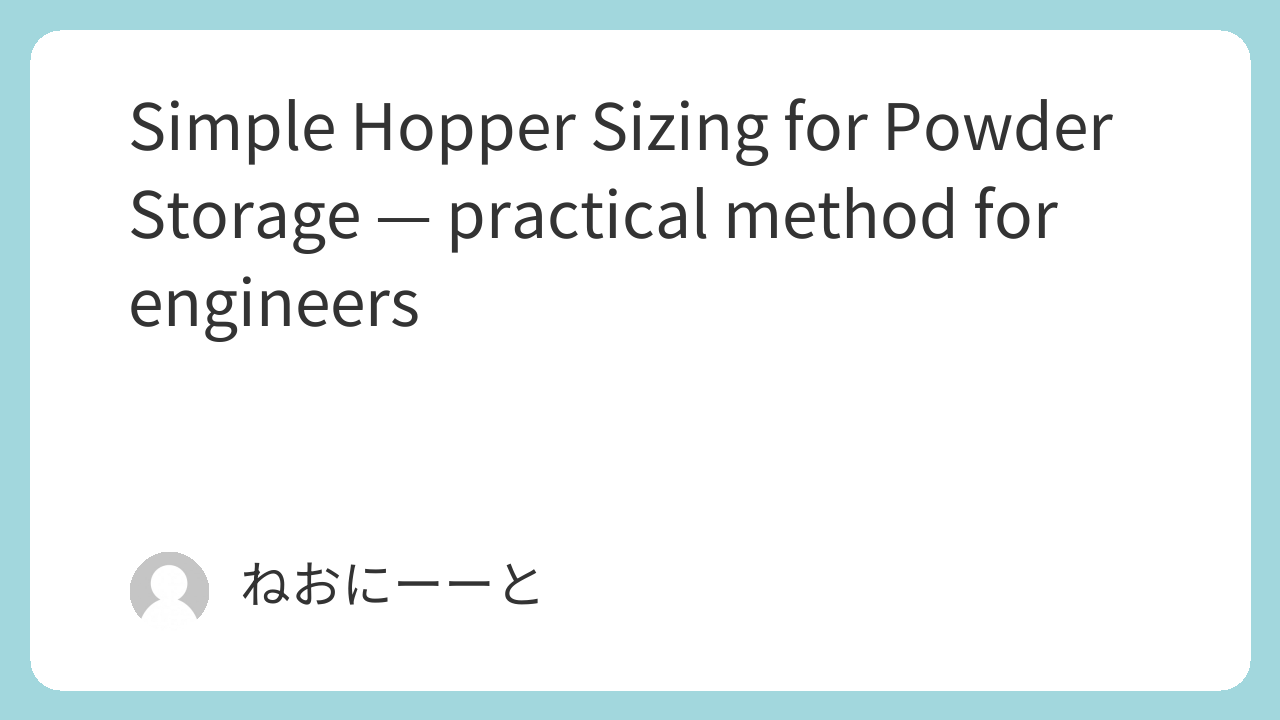Hopper design for powders is mostly a volume problem — but geometric volume ≠ usable powder volume. Powders form piles with a repose angle, so the actual fill height and stored mass can be substantially less than the empty (geometric) volume. This article gives a simple, practical method to size hoppers (concentric and eccentric), convert geometry to powder capacity, and pick outlet/nozzle considerations relevant to real plants.
- 1) Key concepts — geometric vs powder volume
- 2) Basic formulas you can use (concentric hopper)
- 3) How to get the powder (fillable) volume using repose angle
- 4) Eccentric hopper (offset inlet) — practical handling
- 5) Practical design rules & tips (operational checklist)
- 7) Example (conceptual, no numbers)
- Summary
1) Key concepts — geometric vs powder volume
- Geometric (space) volume = the physical internal volume of the hopper (cylinders + conical frustums).
- Powder (usable) volume = the volume actually filled by powder given its angle of repose (θ).
- Angle of repose (θ): the angle (from horizontal) of a stable powder pile. Typical values vary widely (≈20°–50°) depending on particle size, shape and cohesion.
2) Basic formulas you can use (concentric hopper)
For a concentric hopper with:
- top shell diameter D1,
- bottom (outlet) diameter D2,
- conical height Hc (cone/frustum height),
- cylinder (straight) height Hs (if any),
Use these standard formulas (diameters in same units, volume in same³):
Frustum (conical section) volume (between diameters D1 and D2):
$$ V_1=\frac{π}{12}({D_1}^2+D_1D_2+{D_2}^2)*H_1 $$
Cylinder (straight) section volume:
$$ V_2=\frac{π}{4}{D_1}^2H_2 $$
3) How to get the powder (fillable) volume using repose angle
If the powder in the conical part settles as a cone (typical when inlet is centered and flow is simple), base diameter Db and repose angle θ give the cone height hhh:
For a cone of base diameter D,
$$ V_3=\frac{π}{12}{D_1}^2H_3 $$
$$ \frac{D_1}{2}tanΘ_1=H_3 $$
So for the conical part you can:
- Compute the maximum cone height hhh from D and θ.
- If h ≥ actual cone height Hc, the cone fills the whole conical section (use VfrustumV_{\text{frustum}}Vfrustum).
- If h<Hch < H_ch<Hc, the powder occupies a cone of height hhh sitting in the cone — use VconeV_{\text{cone}}Vcone for the conical region.
Note: If the inlet/nozzle is offset (eccentric hopper) or powder is non-free-flowing, the true fill shape is more complex — use conservative assumptions or discrete-event/DEM simulation for accuracy.
4) Eccentric hopper (offset inlet) — practical handling
- Eccentric inlets break symmetry; powder can preferentially pile to one side.
- For conservative design, assume the same cone formula but reduce usable volume by a factor (typical conservative reduction: 5–15%) unless you can model the actual fill.
- When outlet diameter is small relative to hopper diameter, check for arching and ratholing (see next section).
5) Practical design rules & tips (operational checklist)
- Start with the process requirement: define batch size or hold-over time → required powder mass → required usable volume (include safety margin 10–20%).
- Use geometric sizing to ensure equipment fit (space, foundations, lifting).
- Repose angle margin: design hopper wall slope steeper than repose angle by a margin (free-flow powders: +5°; cohesive powders: +10–20° or include flow aids).
- Outlet diameter: make outlet large enough to avoid arching — consult Jenike or known critical diameters for the powder or use vendor data.
- Prefer mass flow for sticky/cohesive powders; funnel flow may be OK for free-flowing powders. Mass flow requires steeper walls and carefully sized outlet.
- Check for bridging and ratholing risks: if present, add agitators, vibrators, aeration pads, or choose alternative discharge (screw conveyors, fluidization).
- Allow maintenance access: manhole, access platforms, and inspection ports.
- Conservative approach for varied materials: if feedstock changes over time, design for the worst (least flowable) material or incorporate adjustable flow aids.
7) Example (conceptual, no numbers)
- Target usable powder volume = batch mass / bulk density × (1 + margin).
- Choose shell diameter D1 consistent with plant layout.
- Choose cone height HcH_cHc and outlet D2 to satisfy both geometric fit and powder-flow needs.
- Calculate VfrustumV_{\text{frustum}}Vfrustum and VcylV_{\text{cyl}}Vcyl; compute cone height from repose angle; pick appropriate powder volume formula; iterate until usable volume ≥ target.
Summary
Sizing a powder hopper is straightforward if you separate geometric volume from actual powder fill. Use the frustum and cylinder formulas to get space volume. Convert to usable powder volume by accounting for the angle of repose (cone height → cone volume). For eccentric inlets, variable powders, or cohesive materials, be conservative: increase hopper slopes, enlarge outlets, or include flow-aid systems. Always convert volume to mass using measured bulk density and include safety margins for operation and maintenance.

Comments